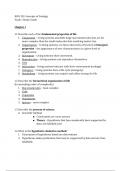Exam (elaborations)
TPNC Exam 1 Study Guide Questions with Answers.
- Course
- Institution
TPNCExam1StudyGuideQuestionswithAnswers. Nosocomial infection - > -infections that occur during hospital admission Iatrogenic infection - > Infections that occurred during medical procedures such as during inserting a urinary catheter, infections acquired specifically from treatment Surgi...
[Show more]








